Content
Peony Laura Dessert is a herbaceous bushy perennial. This variety was developed in 1913 by the French company Dessert. The beautiful milk-flowered peony quickly became popular for its large size and attractiveness. It can be grown in one place for a long time if properly planted and cared for.
Description of peony Laura Dessert
Peony is a popular perennial that can be found in many flower beds. The Laura Dessert variety has the following characteristics:
- the height of the bush is 0.8-1.2 m, it grows strongly, becoming sprawling;
- strong stems;
- fleshy root tubers;
- large and dissected leaves of a dark green color, shine;
- high winter hardiness - Laura Dessert perfectly survives cold weather even at - 34-40 ° C;
- the variety is photophilous, but does not like direct sunlight, the peony feels great in partial shade;
- average resistance to diseases and pests;
- manifestation of varietal qualities for 2-3 years after transplantation;
- the stems of Laura Dessert are strong, therefore no support is needed;
- stability in cutting.
You can grow Laura Dessert peony in different regions. In an area with a harsh climate, it is recommended to make a shelter for the winter.
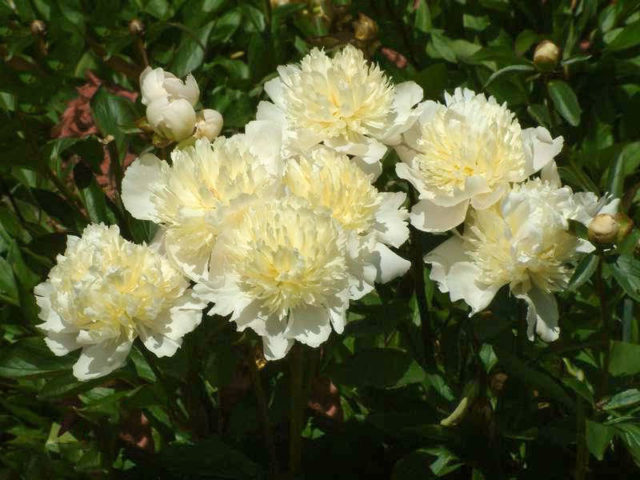
Peony Laura Dessert can grow in one place for more than a dozen years
Flowering features
Peony Laura Dessert is a large-flowered, terry, herbaceous anemone plant. Its flowering time is average. Depending on the region, the bush begins to bloom in late May or early summer. Flowering continues throughout June, occurs sequentially - some flowers are replaced by others.
Laura Dessert is a lush bush with large inflorescences. The outer petals are wide and snow-white, in the center there is a thick yellow-cream crown. The flowers reach 15-16 cm in diameter. Gradually, the inner petals fade to a white-cream color.
The flowers of Laura Dessert attract with their magnificent aroma with light fresh notes of citrus. The splendor of the flowering of a peony depends on several factors:
- Year of plant life - in full force begins to bloom only for 3 years. For the first 2 years, a powerful rhizome develops, therefore, during this period it is recommended to cut off all the buds. For 3 years, the bush will have a maximum of strong shoots and the most magnificent flowering.
- Competent landing... The deepening of the rhizome is important. If it is on the surface, then the peony will suffer in frosts, it may die. With a strong deepening, the bush will be voluminous, but it will not bloom.
- Spaciousness... The proximity of buildings or other obstacles reduces the splendor of Laura Dessert.
- Correct care... The splendor of flowering depends on watering, dressing.
- If you want to achieve a lush flowering of Laura Dessert, then after the formation of the main bud, you do not need to get rid of the lateral buds. They need to be broken out when you want to get large flowers for cutting.
- Laura Dessert should be cut off, leaving at least half of the stem. Together with the leaves, it is important for the further development of the bush, which will affect the splendor of flowering in the future.
- For the splendor of the bush for the next year in the current season, you cannot cut it off very much immediately after flowering or cut it to the ground.
- Disease prevention. Especially on the splendor of flowering, the defeat of the peony by fungi is reflected. It is important to prevent such troubles, and at the first sign of them, to carry out appropriate treatment.
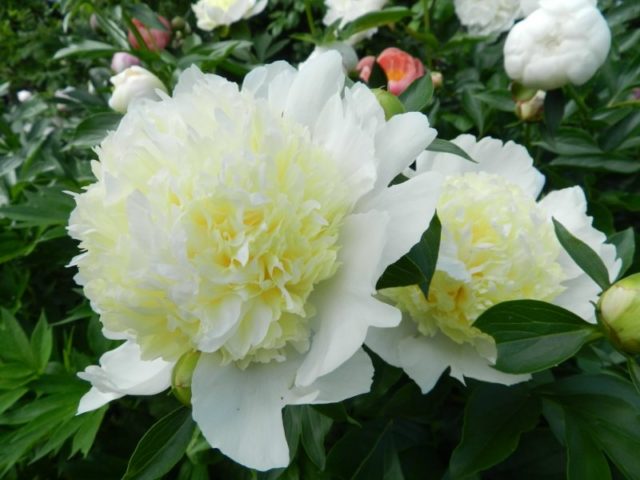
Wide outer petals and small inner petals create a two-tiered shape
Application in design
The splendor of the Laura Dessert variety allows this variety to be grown separately. Even a lonely bush will look good. Peonies look great on a green lawn.
One of the options in landscape design is the creation of a pionarium. Together with Laura Dessert, you can plant other varieties with a similar height, but in different shades - red, crimson, pink.

In a group planting, 3-7 bushes look good
Laura Dessert can be used to create mixborders, combining with other perennials and annuals. Tall peonies will look good next to shrubs, perfectly set off evergreen crops - juniper, boxwood, dwarf pine, thuja. The delicate color of Laura Dessert will perfectly emphasize the unusual color of blue spruces.
Peonies of this variety can be used to create ridges, low hedges. Laura Dessert can be grown in flowerpots, but this variety is too tall for balconies.
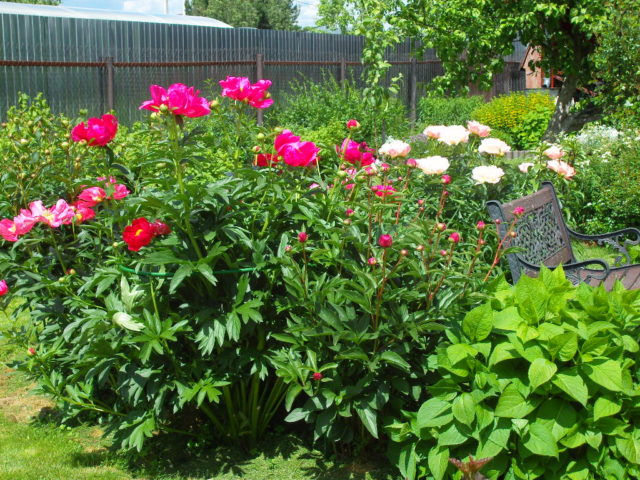
You can combine it with different colors
On small plots, good neighbors for Laura Dessert are badan, cuff, daisies, primrose. The delphinium, foxglove will help to vertically stretch the landings. This technique allows you to balance a large number of lush flowers, to make the composition more accurate.
It is not recommended to plant peonies next to highly growing crops, as they will interfere with their growth. You should also not fill in the gaps between the bushes with other plants. Better to leave room for loosening and watering.
Reproduction methods
Laura Dessert can be propagated in different ways:
- seeds, this option is used by breeders;
- root cuttings - this method is good when you need to get the maximum number of seedlings;
- vertical layering, easy propagation method, suitable for bushes 5-8 years old;
- dividing the bush.
The most effective breeding method for Laura Dessert is by dividing the bush. You need to choose plants for 3-7 years so that the rhizome is well developed. You can divide the bush from the second decade of August to mid-September.
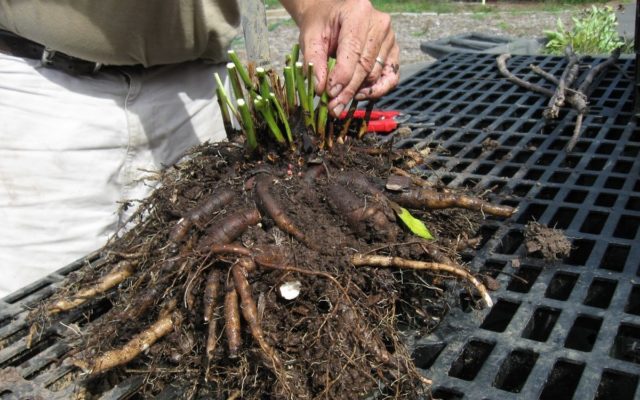
It is necessary to divide the bush after pruning, cuts and breaks to process with charcoal
Landing rules
Planting and transplanting peonies can be carried out in the fall.
For the successful cultivation of Laura Dessert, the following conditions are required:
- well lit area, but shaded at noon;
- lack of drafts;
- remoteness of groundwater, otherwise the roots will rot;
- fertile, well-drained soil;
- loose soil - hard soil means the risk of plant death;
- Laura Dessert prefers loams, slightly acidic soil;
- space - the root system develops well, the bush grows quickly.
If the soil is clayey, then add sand. Sandy soil is corrected with clay. If the soil is acidic, add lime - 0.2-0.4 kg per 1 m².
An important point is the choice of planting material. It is better to refuse old bushes, as they may not take root or die the next year. The best option is a plant from a nursery, which is 1-2 years old, or a part separated from the bush with 2-3 buds and a rhizome of 10-15 cm.
You should plant a peony Laura Dessert as follows:
- Prepare the pit. Deepen by 0.6 m, the width is the same.
- The next day, fill the hole 2/3 with soil mixture. Take equal parts of garden soil, sand, humus, peat.
- Add ash and superphosphate, sprinkle with earth.
- Place the bush in the hole, deepen the root collar by a maximum of 5-7 cm.
- Water the seedling abundantly.
It is recommended to leave 1-1.5 m between adjacent plants.
Follow-up care
Taking care of the Laura Dessert peony is easy. The plant needs the following measures:
- Water every 4-7 days. Watering should be moderate.
- Loosen the soil regularly. Do this after watering, while the ground is wet.
- In the spring, the peony is fed with complex nitrogen fertilizers for growth, development, and a set of green mass. During the period of bud formation and flowering, Laura Dessert needs mineral feeding. It is better to use phosphorus-potassium fertilizers.
- Peonies should be mulched in the spring. It is better to use rotted horse manure, the layer should be small. It is not recommended to use over-matured foliage and straw, this is a risk of fungal diseases.
Preparing for winter
After cutting the peduncles, the peony Laura Dessert must be fed. Phosphorus-potassium fertilizer is introduced. It can be superphosphate and potassium sulfate or wood ash and bone meal. Nitrogen fertilizers cannot be used during this period.
Before the cold weather, Laura Dessert peony requires pruning. The stems are harvested to the very soil, then sprinkled with dry earth. This should be done in mid-October, leave 1-2 cm above the kidneys.
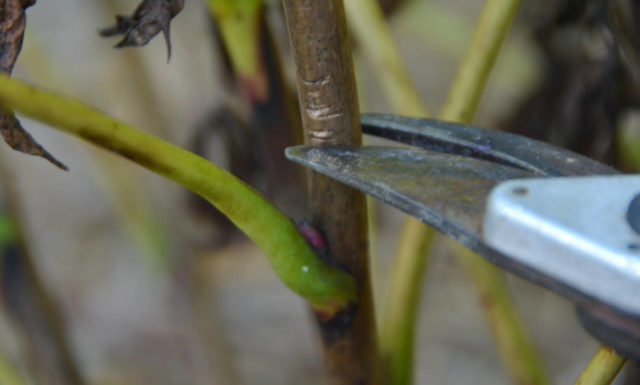
For pruning, you must use a sharp tool, all plant residues after the procedure must be burned
Adult plants do not need shelter, but young peonies in regions with cold or little snowy winters need such protection. Peat, unripe compost, sawdust can serve as a heater. The height of the layer is 5-15 cm. The cut bush can be covered with a wooden box or a plastic container, and dry branches can be placed on top.
Pests and diseases
Peonies are susceptible to fungal diseases. One of the common problems is rust. The affected leaves must be removed and burned. For treatment, Bordeaux liquid (1%) is used, the whole plant is sprayed with it.
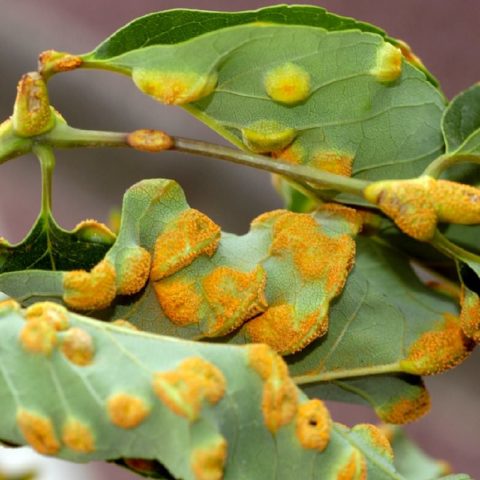
Orange, reddish or brown pads appear on the leaves affected by rust, these are fungal spores
A serious problem is gray rot that affects all parts of the peony. It manifests itself as brown spots around the stem near the root collar, withering of young shoots in the spring, and the appearance of gray bloom (mold) over time. The affected parts of the peony must be cut off, the remaining plantings should be shed with Thiram in a 0.6% suspension. For prevention, the bushes in the spring are sprayed with Bordeaux liquid, get rid of ants.
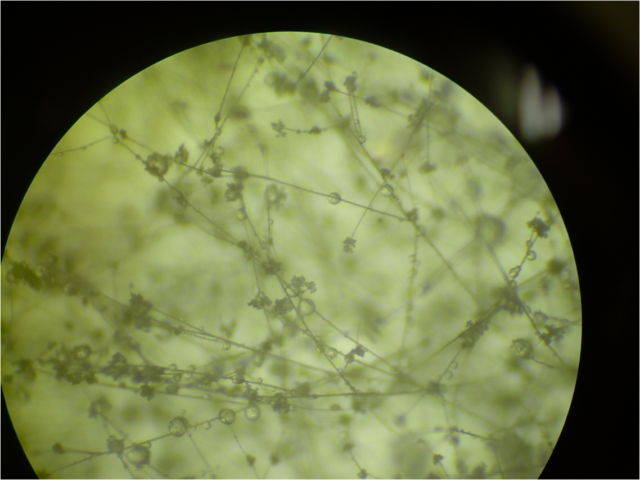
The causative agent of gray rot is the fungus Botrytis cinerea, its spores persist in the soil, plant debris
Adult peonies can be affected by powdery mildew. It manifests itself as a whitish bloom on the upper parts of the leaves. To fight the disease, you can use Figon (2% solution), a solution of laundry soap with soda ash (0.5%). Spray the bushes twice at intervals of 1-1.5 weeks.
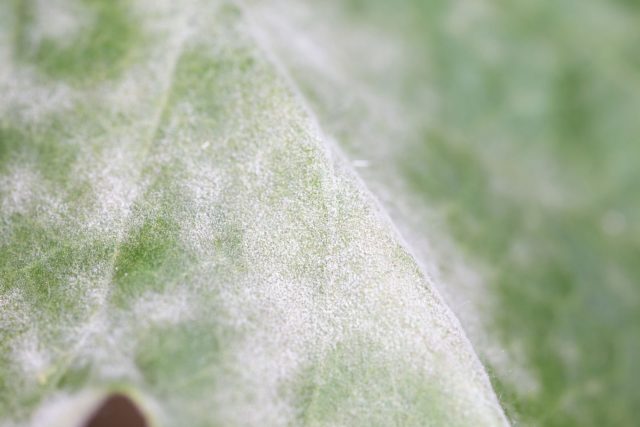
To prevent powdery mildew, it is necessary to burn plant residues, moderately use nitrogen fertilizers, do not forget about potassium-phosphorus dressings
Peony Laura Dessert can also be infected with a virus. One such disease is mosaic. Light green and dark green stripes alternate on the leaf plates.
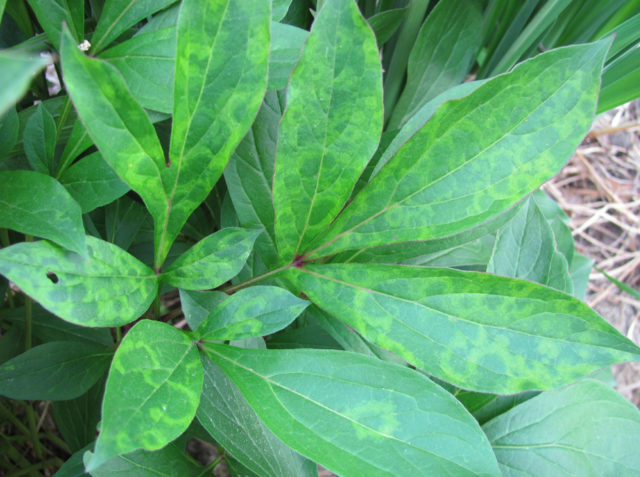
Affected plants cannot be cured, therefore they can only be destroyed
In addition to diseases, peony Laura Dessert can be affected by pests. One of the enemies is ants. They carry viruses, eat leaves with petals. To get rid of pests will help drugs Anteater, Muratsid, Muravyin, Expel. From folk remedies, a decoction of bay leaf, balls of boric acid with honey or jam, infusions of tansy, wormwood, lavender, mint, anise are effective.
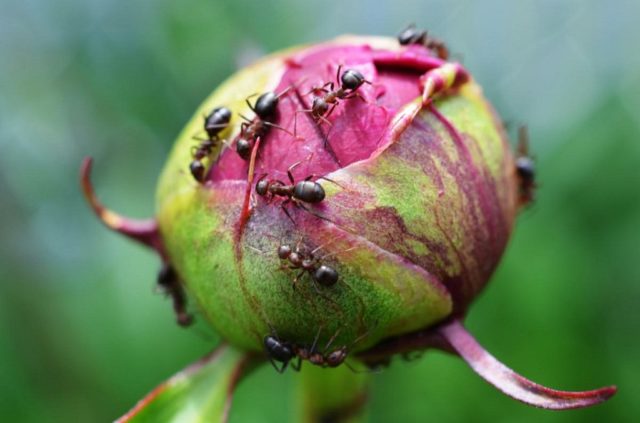
If ants appear on buds that have not yet blossomed, then the flowers may not open at all or will be deformed
Another pest of the peony is aphid. This small insect feeds on plant sap, attracts ants, and carries diseases. Actellik, Fitoverm will help get rid of him.
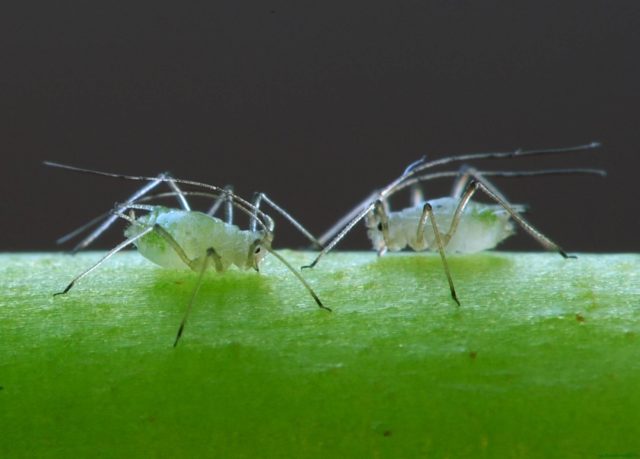
If there are not many aphids on the bushes, then you can collect it by hand, ladybugs are the natural enemies of the pest.
Dangerous for peony is golden bronze. The beetle reaches 2.3 cm in length. It feeds on petals, leaves, stems. Beetles must be collected by hand; insecticides can be used during the budding period.
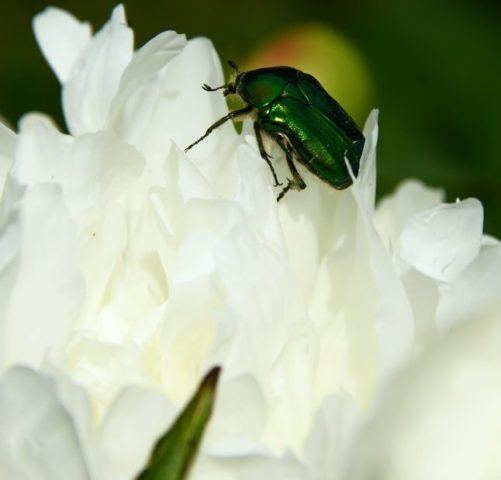
To prevent the appearance of bronze, it is necessary to regularly loosen the soil at the end of summer, and this period accounts for the pupation of the insect
Peony roots can be attacked by rootworm nematodes. This is manifested by nodular swellings, inside which there are worms. Affected plants must be removed and burned; Formalin (1%) must be used to disinfect the soil.

The prevention of gall nematode is the burning of plant sediments, deep digging of the soil before planting, careful selection of planting material
During the growing season, you can see the larvae of thrips on peonies, and when buds form, these small insects feed on the sap of the petals. A solution of Karbofos (0.2%) will help get rid of pests. Spraying is carried out several times per season.
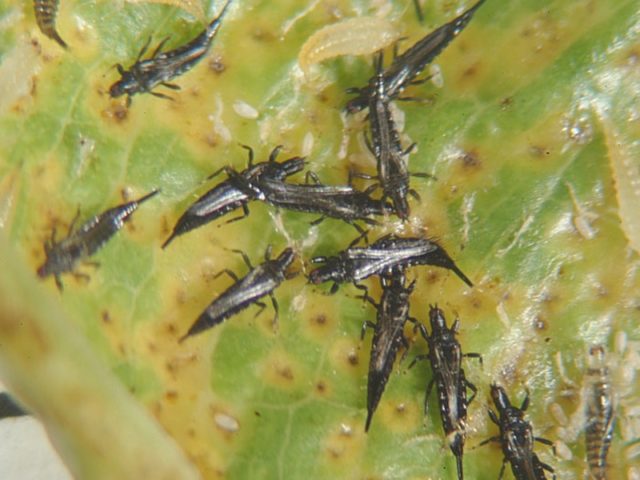
Thrips can be dealt with using folk methods - infusions of yarrow, dandelion
Conclusion
Peony Laura Dessert is a herbaceous perennial with large flowers and a delicate creamy color. It can be combined with many plants, used in single and group plantings. Peony is unpretentious in care, is not afraid of cold weather, it can grow in one place for up to 30 years.
Reviews of the peony Laura Dessert
https://www.youtube.com/watch?v=-sSiEiqNLOs








